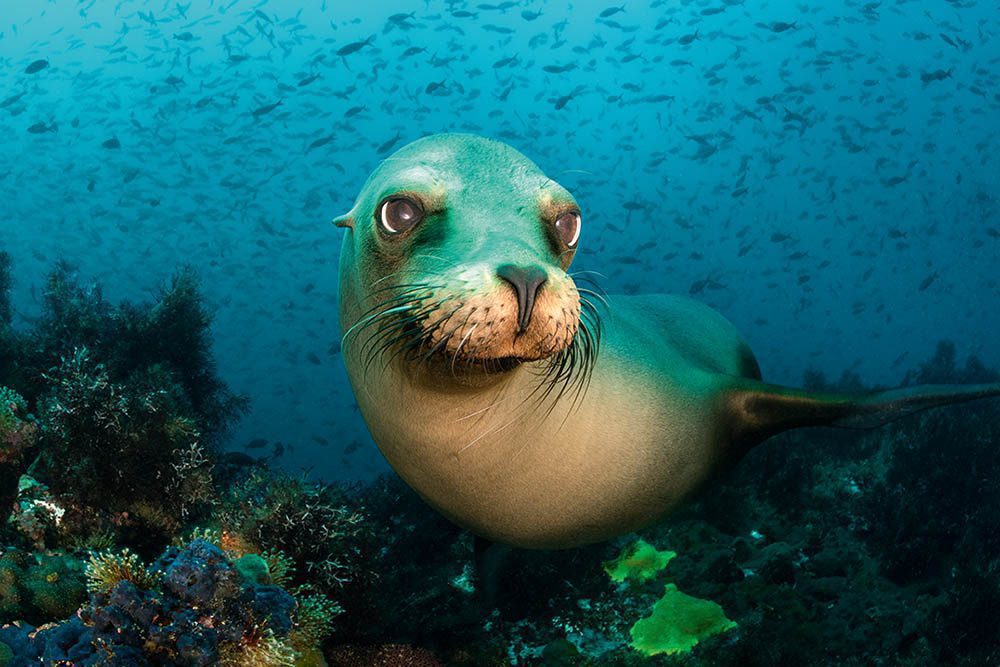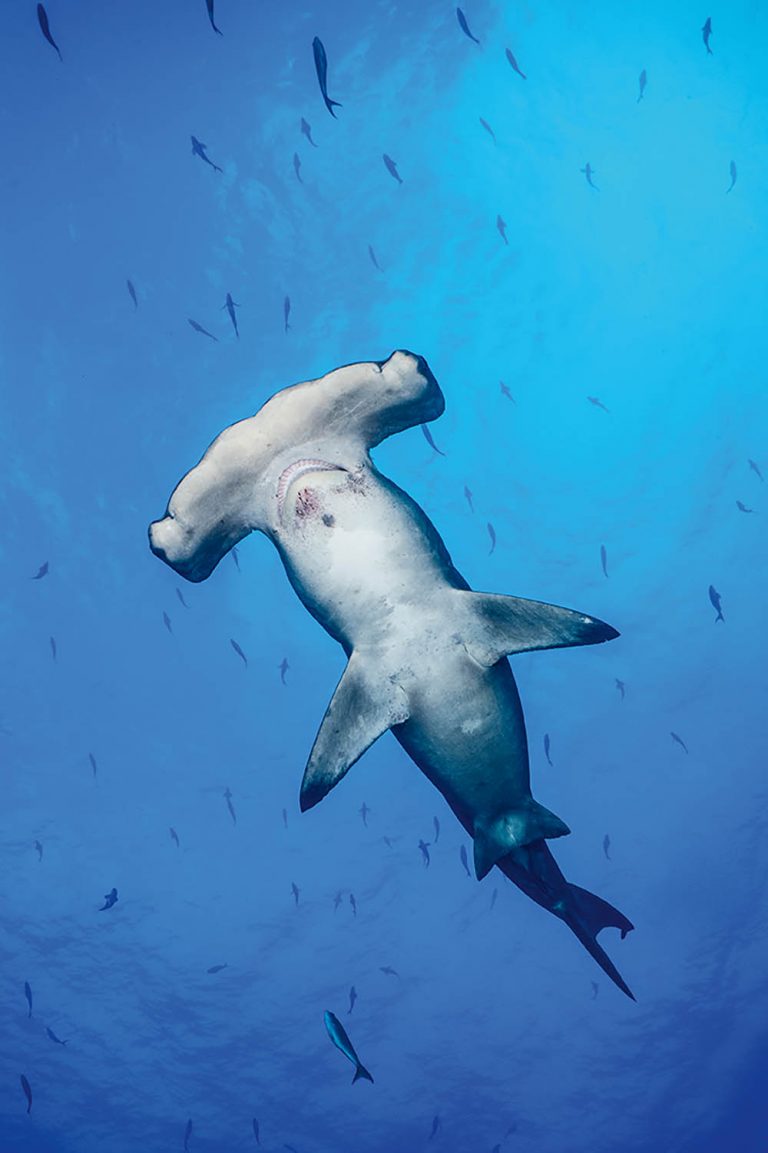PHOTO TECHNIQUE
Be The Champ!
When underwater photographers find themselves in one of the world’s richest magnets for big marine-life, the question is how to use all those precious moments to best effect. ALEX MUSTARD is here to help
‘Galapagos deserves its reputation as the sharkiest place on Earth’

Pictured: Scalloped hammerheads are the iconic Galapagos dive attraction. Although abundant, they don’t always come into photographic range. Nikon D5 and Nikon 28-70mm, Nauticam WACP, Subal housing,Retra flashes. 1/320th @ f/8, ISO 640.
GALAPAGOS IS A BUCKET-LIST destination for just about everyone who has ever breathed through a regulator. Tough, arid conditions on land shape the islands’ natural history; animals that arrived here either died or adapted, evolving over the millennia into new species.
The islands support 7000 species of flora and fauna, and 97% of the reptiles and 80% of the land birds exist nowhere else. Little wonder that a curious mind like Charles Darwin’s was sparked into considering the origin of species here.
The hardships that species face on land do not continue under water.
For ocean life the Galapagos archipelago is an Eden.
It provides almost perfect conditions year-round for marine species to flourish with a magnitude and vitality few locations on the planet can match.
Four major ocean currents converge on the islands and supercharge the entire marine food-chain. Galapagos seas churn with fish, which in turn provide for large populations of predators: rays, whales, dolphins, sea-lions and the vast colonies of seabirds.
Galapagos deserves its reputation as the sharkiest place on Earth. Schools of hammerheads are on most dive-sites and other species are plentiful, notably silky, Galapagos and whale sharks.
The rub, and there is always a rub, is that Galapagos diving is often very challenging.
The conditions are hard to predict: the water is regularly cold, visibility is poor and strong currents are common, which can be particularly intimidating in a remote, open-ocean location.
Many divers find the challenge addictive, returning again and again. For others, this is a location that they will tell tales of on every future dive-trip, but are content to leave unrepeated.
Appeared in DIVER February 2019
FOR THOSE OF US with cameras, Galapagos presents a stern challenge. We can expect phenomenal subject matter but the conditions make it tough to capture. At times the raging currents even make it difficult to point our camera in the right direction!
Preparation is key to success. We should do as much of our photographic planning on the boat as possible, to be ready for whatever comes along.
Gear-wise, the unpredictable nature of the diving and encounters make this the realm of the wide-angle zoom lens. Long strobe arms are also de rigueur, because there is little close-focus wide-angle, and most subjects are shot through a fair amount of murky water. That said, when currents are especially fierce we might choose to dive without strobes for ease of handling – a sensible option, because many of the larger species photograph well in available light, or as silhouettes.
Although we are often instructed to settle among the rocks on Galapagos dives, I choose to dive in freediving fins for the extra thrust they offer when you need to move against strong currents to get into the best shooting position.
These aren’t the fins for manoeuvring in delicate coral environments, but well-suited to the open water of Galapagos, where many guides choose them too.
Most divers wear gloves in Galapagos to protect them from the sharp barnacle-covered volcanic rocks and to keep their hands warm on colder dives. Choose gloves that provide the dexterity to access the functions of your housing, or consider trimming the fingers and thumb on the right one to help.
Finally, use a good lanyard or clip for the camera to enable you to deploy your SMB from depth, before drifting away from the reef.
STARTER TIP
Hammerheads are abundant in Galapagos, but they won’t always come into photographic range. So set out to enjoy the show either way, rather than defining your enjoyment of the dive by the photos!
Once they start to come close, stay down and breathe as slowly and smoothly as you can and keep shooting.
SCALLOPED HAMMERHEAD sharks are the diving icon of the Galapagos and very abundant. They can be seen even at shallow depths, but they are not typically an easy species to photograph.
The usual technique is to descend to the reef in a group with the dive-guide and wait near a cleaning station, usually set up by barberfish (a yellow butterfly fish) or attractive king angelfish.
Our first job is to get comfortable and secure from the current, then to use the waiting time to get our settings dialled in. I always set up for a reasonably close pass, because I prefer to be optimised and hope to get lucky with a good pass, rather than trying to get something passable of more distant action.

Try to capture the richness of life in the backgrounds of your big-animal shots. Taken with a Nikon D5 and Nikonos 13mm, Subal housing, Retra strobes. 1/125th @ f/14, ISO 500.
The basic set-up is strobes out wide to minimise backscatter, with their power turned up and the camera’s aperture open a little more than usual to help get flash on the subject.
Next we should adjust the ISO so that shooting just upwards of horizontal we end up with a shutter speed of about 1/125th. This gives us flexibility to adjust the shutter-speed down when shooting down the slope and up when shooting towards the surface, depending where the sharks are.
Hammerhead sharks don’t like bubbles. Ideally try to position yourself at one end of the dive group. At times you will be at the far end from the action, but at others you will get the closest encounters.
One of the things we are first taught as divers is not to hold your breath, so I can’t advise that. Instead, when the hammers are really coming in, I try to breathe so slowly that no bubbles come out for those critical few seconds!
MID-WATER TIP
Big marine life defines Galapagos diving, so make this the focus of your photography. Even when you want to capture the underwater vistas, try to incorporate the bigger animals into your images.
The abundance of subjects is such that you can usually rely on something swimming into your backgrounds to help demonstrate the riot of life.

Above: Expect the unexpected and be ready to shoot when it happens. Taken with a Nikon D5 and Nikon 28-70mm, Nauticam WACP, Subal housing, Retra flashes. 1/100th @ f/11, ISO 640.
OTHER SHARKS AND RAYS are less tricky. Galapagos sharks often make reliable circles of the reef, so if we hide behind a boulder on their standard circuit, we should get frame-fillers. The same tactic works with eagle rays.
Mantas typically have a specific cleaning station in mind. If we don’t chase after them, they will usually come in too close for even the widest lens.
Silky sharks tend to show up in the blue at the end of the dive and come in closer as the number of divers drops, as folks surface. Waiting to the end can often yield a pleasing couple of frames.
Whale sharks usually appear with little warning, and require us swimming out into the blue after them. If the shark is already alongside, you won’t catch it and it’s often better to stay put and wait.
Whale sharks often cruise up and down the reef, and regularly reappear later in the dive. The whale sharks in Galapagos are large adults, much bigger than we tend to see in other places, and can look amazing surrounded by the dense fish-life.
Galapagos offers countless other photo opportunities, from endemic Galapagos sea-lions to the Galapagos penguins. There is even interesting macro, including the red-lipped batfish, colourful nudibranchs and characterful barnacle blennies. However, it’s a brave photographer who forgoes a wide-angle zoom for a dive to capture such subjects!
Perhaps the most addictive aspect of diving in Galapagos is that you feel absolutely anything can happen and, more often than not, it does.
Talk to divers who have visited and they will all have a stand-out, jaw-dropping encounter to relate, and it will always be different.
Just about any animal in the oceans can turn up here and provide that shot of a lifetime, as long as we’re ready!
ADVANCED TIP
Speak to the guides, and if they expect the currents to be raging, consider diving with just a single strobe, or go without strobes at all to make the rig easier to handle.
Many of the big animals such as sharks, sea-lions, turtles and rays look great as silhouettes, or as available-light shots converted to black and white.

